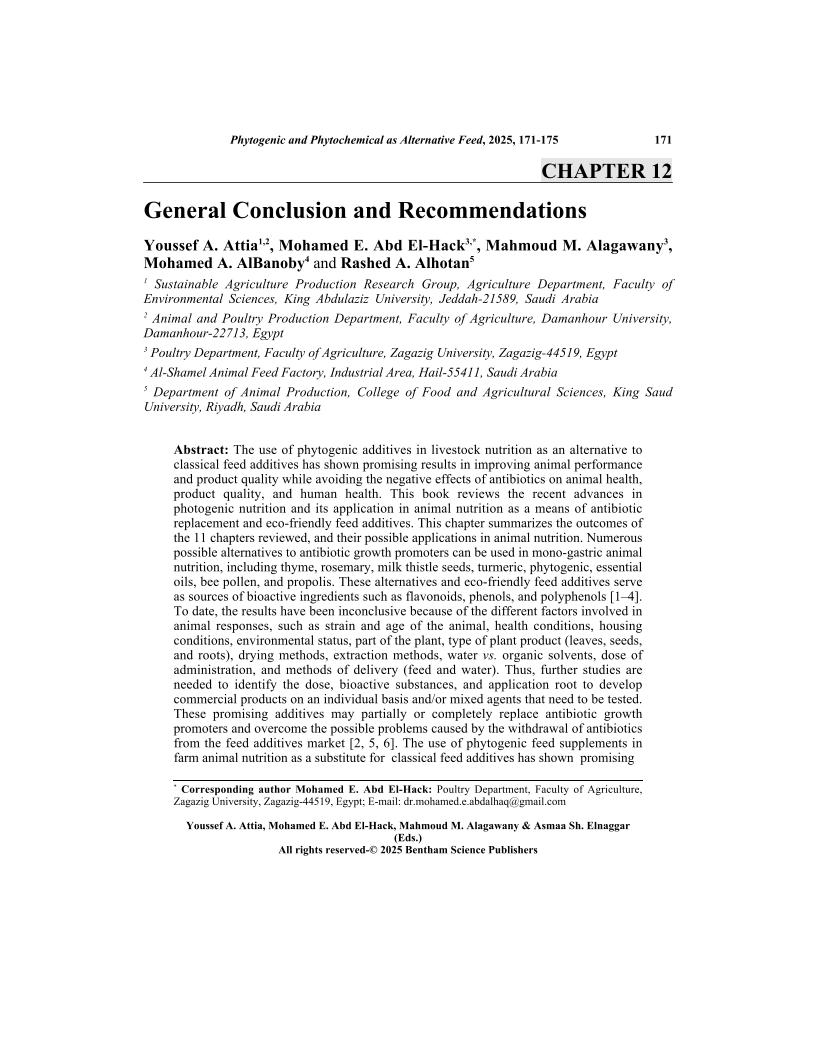General Conclusion and Recommendations

- Authors: Youssef A. Attia1, Mohamed E. Abd El-Hack2, Mahmoud M. Alagawany3, Mohamed A. AlBanoby4, Rashed A. Alhotan5
-
View Affiliations Hide Affiliations1 Sustainable Agriculture Production Research Group, Agriculture Department, Faculty of Environmental Sciences, King Abdulaziz University, Jeddah 21589, Saudi Arabia 2 Poultry Department, Faculty of Agriculture, Zagazig University, Zagazig-44519, Egypt 3 Poultry Department, Faculty of Agriculture, Zagazig University, Zagazig-44519, Egypt 4 Al-Shamel Animal Feed Factory, Industrial Area, Hail-55411, Saudi Arabia 5 Department of Animal Production, College of Food and Agricultural Sciences, King Saud University, Riyadh, Saudi Arabia
- Source: Phytogenic and Phytochemical as Alternative Feed Additives for Animal Production , pp 171-175
- Publication Date: March 2025
- Language: English
General Conclusion and Recommendations, Page 1 of 1
< Previous page | Next page > /docserver/preview/fulltext/9789815322767/chapter-12-1.gif
The use of phytogenic additives in livestock nutrition as an alternative to classical feed additives has shown promising results in improving animal performance and product quality while avoiding the negative effects of antibiotics on animal health, product quality, and human health. This book reviews the recent advances in photogenic nutrition and its application in animal nutrition as a means of antibiotic replacement and eco-friendly feed additives. This chapter summarizes the outcomes of the 11 chapters reviewed, and their possible applications in animal nutrition. Numerous possible alternatives to antibiotic growth promoters can be used in mono-gastric animal nutrition, including thyme, rosemary, milk thistle seeds, turmeric, phytogenic, essential oils, bee pollen, and propolis. These alternatives and eco-friendly feed additives serve as sources of bioactive ingredients such as flavonoids, phenols, and polyphenols [14]. To date, the results have been inconclusive because of the different factors involved in animal responses, such as strain and age of the animal, health conditions, housing conditions, environmental status, part of the plant, type of plant product (leaves, seeds, and roots), drying methods, extraction methods, water vs. organic solvents, dose of administration, and methods of delivery (feed and water). Thus, further studies are needed to identify the dose, bioactive substances, and application root to develop commercial products on an individual basis and/or mixed agents that need to be tested. These promising additives may partially or completely replace antibiotic growth promoters and overcome the possible problems caused by the withdrawal of antibiotics from the feed additives market [2, 5, 6]. The use of phytogenic feed supplements in farm animal nutrition as a substitute for classical feed additives has shown promising results in enhancing animal performance and product quality, while avoiding the negative effects of antibiotics on human and animal health, product quality, and food security and safety.
-
From This Site
/content/books/9789815322767.chapter-12dcterms_subject,pub_keyword-contentType:Journal -contentType:Figure -contentType:Table -contentType:SupplementaryData105

